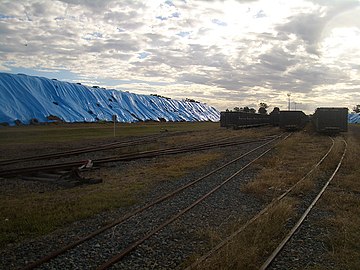
Back كتلة حيوية خشبية Arabic Lignocellulose German Biomasa lignocelulósica Spanish Lignotselluloos Estonian Lignozelulosa Basque زیستتوده لیگنوسلولزیک Persian Lignoselluloosa Finnish Lignocellulose French Lignocellulosa Italian Lignocellulose Dutch

Lignocellulose refers to plant dry matter (biomass), so called lignocellulosic biomass. It is the most abundantly available raw material on the Earth for the production of biofuels.[1] It is composed of two kinds of carbohydrate polymers, cellulose and hemicellulose, and an aromatic-rich polymer called lignin.[1] Any biomass rich in cellulose, hemicelluloses, and lignin are commonly referred to as lignocellulosic biomass.[2] Each component has a distinct chemical behavior. Being a composite of three very different components makes the processing of lignocellulose challenging. The evolved resistance to degradation or even separation is referred to as recalcitrance. Overcoming this recalcitrance to produce useful, high value products requires a combination of heat, chemicals, enzymes, and microorganisms.[3][4][5][6] These carbohydrate-containing polymers contain different sugar monomers (six and five carbon sugars) and they are covalently bound to lignin.
Lignocellulosic biomass can be broadly classified as virgin biomass, waste biomass, and energy crops. Virgin biomass includes plants. Waste biomass is produced as a low value byproduct of various industrial sectors such as agriculture (corn stover, sugarcane bagasse, straw etc.) and forestry (saw mill and paper mill discards). Energy crops are crops with a high yield of lignocellulosic biomass produced as a raw material for the production of second-generation biofuel; examples include switchgrass (Panicum virgatum) and elephant grass. The biofuels generated from these energy crops are sources of sustainable energy.[7][8]
- ^ a b Wyman, Charles E.; Dale, Bruce E.; Elander, Richard T.; Holtzapple, Mark; Ladisch, Michael R.; Lee, Y. Y. (2005-12-01). "Coordinated development of leading biomass pretreatment technologies". Bioresource Technology. 96 (18): 1959–1966. doi:10.1016/j.biortech.2005.01.010. ISSN 0960-8524. PMID 16112483.
- ^ Zhou, Chun-Hui; Xia, Xi; Lin, Chun-Xiang; Tong, Dong-Shen; Beltramini, Jorge (2011-10-17). "Catalytic conversion of lignocellulosic biomass to fine chemicals and fuels". Chemical Society Reviews. 40 (11): 5588–5617. doi:10.1039/C1CS15124J. ISSN 1460-4744. PMID 21863197.
- ^ Y. Sun, J. Cheng (2002). "Hydrolysis of Lignocellulosic Materials for Ethanol Production: a Review". Bioresour. Technol. 83 (1): 1–11. doi:10.1016/S0960-8524(01)00212-7. PMID 12058826.
- ^ E. Palmqvist; B. Hahn-Hagerdal (2000). "Fermentation of Lignocellulosic Hydrolysates. II: inhibitors and Mechanisms of Inhibition". Bioresour. Technol. 74: 25-33. doi:10.1016/S0960-8524(99)00161-3.
- ^ P. Alvira; E. Tomas-Pejo; M. Ballesteros; M. J. Negro (2010). "Pretreatment Technologies for an Efficient Bioethanol Production Process Based on Enzymatic Hydrolysis: A Review". Bioresour. Technol. 101 (13): 4851–4861. doi:10.1016/j.biortech.2009.11.093. PMID 20042329.
- ^ D. M. Alonso; J. Q. Bond; J. A. Dumesic (2010). "Catalytic Conversion of Biomass to Biofuels". Green Chem. 12 (9): 1493-1513. doi:10.1039/c004654j.
- ^ Güleç, Fatih; Parthiban, Anburajan; Umenweke, Great C.; Musa, Umaru; Williams, Orla; Mortezaei, Yasna; Suk‐Oh, Hyun; Lester, Edward; Ogbaga, Chukwuma C.; Gunes, Burcu; Okolie, Jude A. (12 October 2023). "Progress in lignocellulosic biomass valorization for biofuels and value‐added chemical production in the EU : A focus on thermochemical conversion processes". Biofuels, Bioproducts and Biorefining. doi:10.1002/bbb.2544.
- ^ Saladini, Fabrizio; Patrizi, Nicoletta; Pulselli, Federico M.; Marchettini, Nadia; Bastianoni, Simone (December 2016). "Guidelines for emergy evaluation of first, second and third generation biofuels". Renewable and Sustainable Energy Reviews. 66: 221–227. doi:10.1016/j.rser.2016.07.073.
© MMXXIII Rich X Search. We shall prevail. All rights reserved. Rich X Search